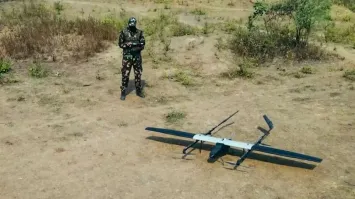Indian Army Allegedly Used Polish ‘Warmate’ Drones in July 13 Attack, Claims ULFA-I and PLA
Summary
On July 13, 2025, a joint statement released by ULFA-I (United Liberation Front of Asom – Independent) and PLA (People’s Liberation Army of Manipur) alleged that the Indian Army used Polish-made ‘Warmate’ kamikaze drones during a strike at the Indo-Myanmar border. According to the insurgent groups, the target was their joint camp in Sagaing Region, Myanmar, which was destroyed by drone-launched munitions. This marks a significant development in counter-insurgency tactics in Northeast India, indicating possible use of precision drone warfare. While the Indian Army hasn’t officially confirmed the use of such drones, the claim, if true, suggests a tactical shift in how anti-insurgency operations are conducted in border areas.
In-depth Article
Introduction: Are Drones Changing the Face of Border Conflicts in Northeast India?
Have you ever imagined warfare straight out of a sci-fi movie—small, buzzing drones zipping through forest canopies and crashing into enemy camps with pinpoint precision? Sounds surreal, right? But according to a joint claim by ULFA-I and the PLA, that’s exactly what happened on July 13, 2025, at the Indo-Myanmar border. The alleged use of Polish-made ‘Warmate’ kamikaze drones by the Indian Army in an offensive strike might be a game-changer in how India handles insurgency threats in its restive Northeast.
Let’s break it down in plain English: this isn’t your usual boots-on-the-ground operation. This is next-gen warfare that takes no prisoners and leaves behind no footprints.
What Really Happened on July 13, 2025?
According to a detailed press release issued jointly by ULFA-I and PLA, a drone strike targeted their joint camp in Sagaing, Myanmar, completely obliterating key facilities. The release claimed that ‘Warmate’ drones, manufactured by Polish defense firm WB Electronics, were used in the attack.
These aren’t ordinary drones you’d see at a wedding shoot. ‘Warmate’ drones are loitering munitions—basically, they hang around the target area, find a high-value target, and then dive into it like a guided missile.
The joint camp, described as a strategic base used for training, logistics, and coordination, was allegedly reduced to rubble. No official number of casualties was released by the insurgents, but the statement admitted to “loss of infrastructure and personnel.”
What Are Warmate Drones? A Closer Look
Let’s geek out a bit. The Warmate drone is a kamikaze or suicide drone, designed for tactical missions that need surgical precision. Think of it as a flying sniper with explosive tips.
- Manufacturer: WB Electronics, Poland
- Weight: ~5.7 kg
- Range: Up to 12 km
- Flight Time: 70 minutes
- Payload: High-explosive warhead
- Purpose: Targeted strikes against light vehicles, enemy positions, and bunkers
Warmates are popular in modern warfare because they reduce risk to soldiers while providing pinpoint accuracy. Ukraine, for instance, used them extensively during its conflict with Russia. Now, if the Indian Army is deploying these in counter-insurgency ops, it signals a massive leap in tactical warfare in the Northeast.
Conclusion: War Has Wings Now
What happened on July 13, 2025, might look like a footnote in the grand book of military history, but it’s much more. It signals the Indian Army’s embrace of cutting-edge, asymmetrical warfare in regions long plagued by insurgency. Whether or not the Army confirms the use of Warmate drones, one thing is certain—technology has landed in the jungles of Northeast India, and the battlefield will never be the same.
So next time you hear a buzz overhead in the mountains of Manipur or forests of Assam, remember—it might not be a bird or a plane. It could be the future of warfare, flying silent and deadly.
FAQs
- What are Warmate drones and who makes them?
Warmate drones are Polish-made loitering munitions designed for precision strikes. They’re essentially kamikaze drones that can circle a target before diving in with an explosive payload. - Did the Indian Army confirm the July 13 drone strike?
No official confirmation has been made. The claim came from a joint press release by ULFA-I and PLA insurgent groups. - Is it legal for India to strike inside Myanmar?
India and Myanmar have past agreements for cross-border anti-insurgency ops. If the strike was coordinated, it could be considered legal; if not, it raises international law concerns. - Will drone warfare become common in Northeast India?
Given the success of this alleged strike, drones are likely to play a bigger role in future anti-insurgency operations in India’s Northeast. - Can insurgents also start using drones in retaliation?
It’s possible. As technology becomes more accessible, there’s a real threat of insurgent groups using drones for surveillance or attacks, which makes counter-drone measures essential.


